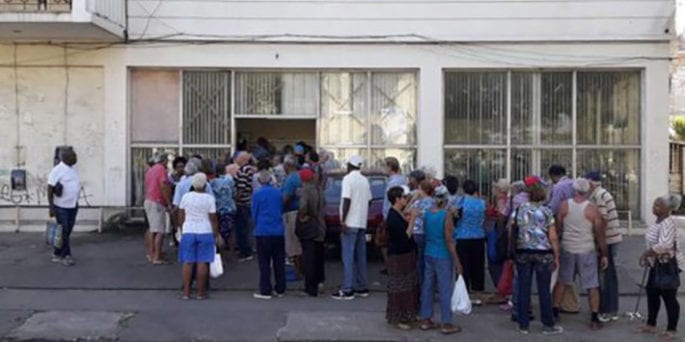Medicine Shortages Persist in Cuban Pharmacies
A social problem with an economic background

HAVANA TIMES — Medicine shortages in Cuba share a common root cause with other areas in the country’s fragile economy: the lack of liquid funds which has made it impossible for them to meet payments to foreign suppliers.
This illiquidity is growing because of the decline in exports, the fall in prices of important export products such as sugar and nickel (which have also declined in production) as well as limited sources of capital accumulation and insufficient funding.
The worsening economic crisis in Venezuela hasn’t helped either. Cuba’s main ally has sharply reduced its oil deliveries to the island from the approximately 100,000 barrels per day in 2016 to a figure that the government still hasn’t disclosed.
The panorama becomes even bleaker because longed-after foreign investments dribbles in slowly. The government says there is a lot of interest but much is only at the commitment level. Another factor is the heavy burden of foreign debt repayments.
According to the Cuban government, the US embargo (which Cuba calls a blockade) plays a vital role in the island’s financial problems. Cuba claims that it has suffered losses of over 130 billion USD over the last half century.
A boom in tourism (over 4.7 million visitors in 2017) has provided some relief, as have family remittances (unofficially estimated at between 2.5 and 3 billion USD per year), and the exporting of medical services. According to economists, these three sectors have brought in more than 70% of Cuba’s annual revenue in hard currency.
The medicine drama
Medicine shortages have been happening since the second half of 2016, continued in 2017 and are being repeated in the first two months of this year, as we verified in visits to pharmacies in the capital’s municipalities of Central Havana and Revolution Square.
“Beyond improvements, the medicine shortages situation in the country continue to persist,” the government’s newspaper Granma recognized on February 3rd.
Last November, executives from the state-owned BioCubaFarma company and the Public Health Ministry had claimed that medicine availability in its pharmacy network would gradually become more stable.
However, lines of unhappy consumers continued in January 2018 and in the first week of February. Most people come in hordes within the first 24 hours after medicine deliveries are made, although some medicines run out in the first few hours on the same morning.
“I have come from Cerro (a neighborhood in the south-eastern part of the capital) and I couldn’t find dipirona (the most used painkiller and antipyretic drug in Cuba) or venaton (for blood circulation) or even cough syrup,” Hector Herrera, a 72-year-old pensioner, said outraged.
Medicines controlled by a card for chronic illnesses such as high blood pressure, diabetes, asthma and heart-related or cerebrovascular diseases, which make up 47% of the basic list of local production, are the ones in greatest shortage.
The National Assembly Discussed the Medicine Shortages
Medicine shortages were analyzed during the brief National Assembly Session in the second half of December 2017.
The Public Health Minister, Roberto Morales Ojeda, explained that 2018 will be a year that the government makes great efforts, in both a financial and industrial sense and he pointed out that 49 medicines are “missing”, 44 of which are produced in Cuba and only five of which are imported.
Medicines are subsidized by the State and are sold for a cheaper price than what their production actually costs. The president of the state-run CubaBioFarma company, Eduardo Martinez, attributed the “instability” of its sales to the financial restrictions which the country is facing, made worse by the US blockade.
He specified that out of the 801 medicines on the basic list of medicines, 505 (63%) are produced by the national industry and 296 (37%) are imported, as well as 144 natural products available on the National Health System.
In the midst of this panorama, the Cuban Finances and Prices Minister, Lina Pedraza, announced before Parliament also in December that 10.565 billion pesos (422.6 million USD, according to the state-controlled CADECA exchange rate) will be dedicated to the Health sector in 2018.
Distant markets make imports more expensive
Over 85% of the ingredients that are used to make medicines in Cuba are imported and 92% of active components come from distant markets such as China, India and Europe, as well as 60% of packaging materials.
Cuban authorities have tried to have greater control over the illegal sale of medicines, but some pharmacists are associated with black market resellers in the profitable business which, in times like the present, have helped many with their treatment.
Martinez furthermore revealed that in the first semester of 2017, financial losses were estimated to be 575,345 pesos (approximately 25,000 USD) in the group of biotechnology and pharmaceutical industries.






It comes to no surprise that even the small pharmacies located inside tourists hotels which sell products in CUC are better-stocked with a wider variety of medicines than the pharmacies set up for Cubans which sell products in the national currency. The argument that medicines are not available in Cuban is false. What is true is that most medicines is too expensive for most Cubans.
I just take a lot of over the counter medicines when i go 3 x a year and leave them, hoping it is of some small help .
It makes no sense that Cuba provides medicines and contracts out medical services in many countries but can’t keep its own pharmacies stocked with the basics. I don’t see how the US embargo is to blame.